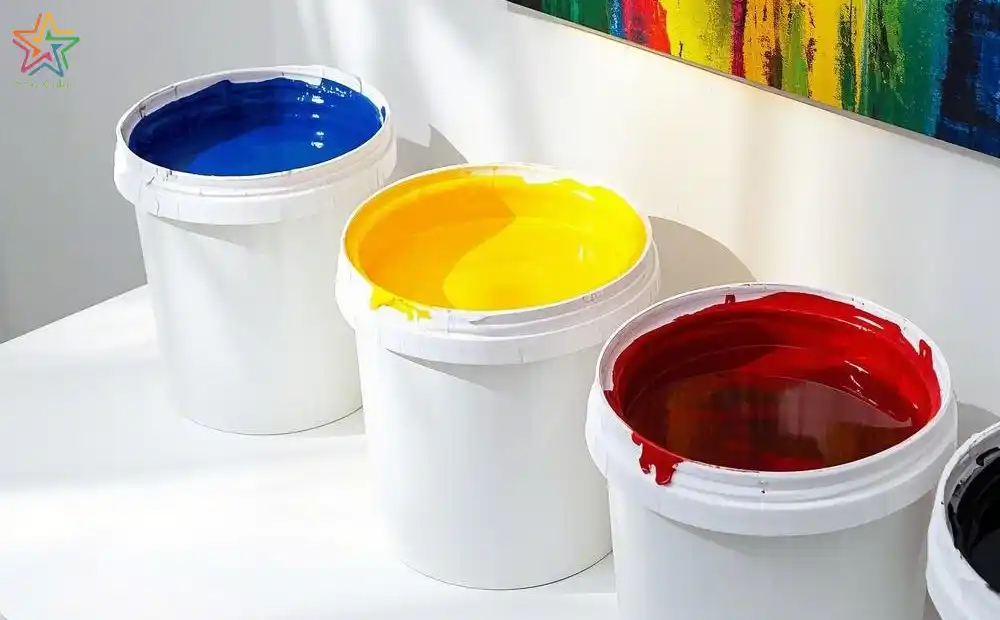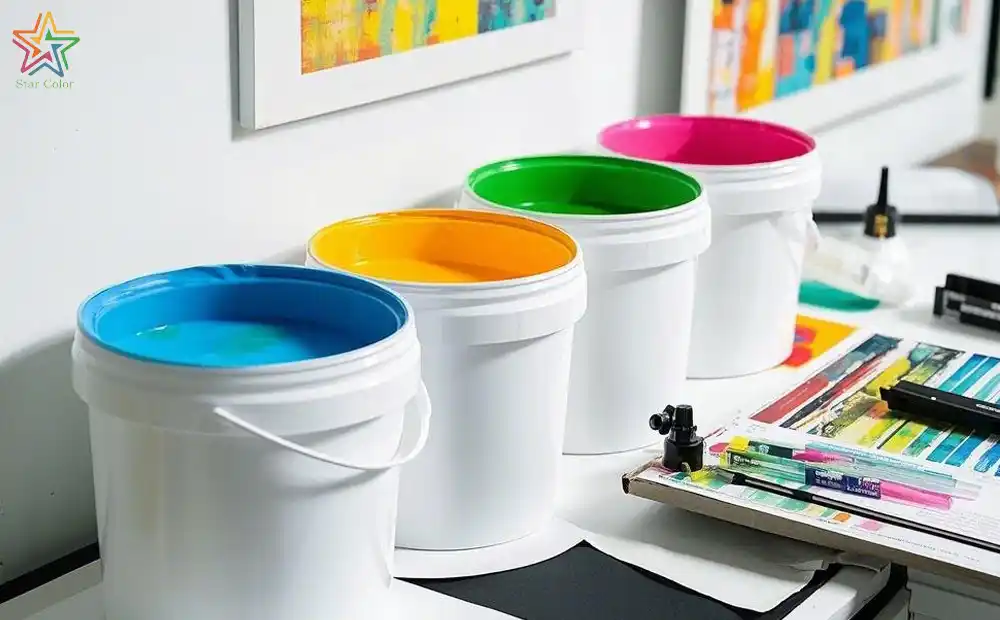Acrylic vs. Polyurethane Water-Based Inks
Date: May 09 2025 From: Star Color Views:
With the vigorous development of green printing technology, acrylic and polyurethane water-based inks have become two mainstream systems, widely used in packaging, textiles, electronics, and other fields due to their low VOC emissions and safe, environmentally friendly properties. Although both belong to the category of water-based inks, their fundamental differences in chemical structure and curing mechanisms lead to significant disparities in physical properties, environmental performance, and application scenarios. Drawing on over a decade of experience in the printing industry, this article analyzes the differences between these two ink systems from the molecular level to practical applications, incorporating authoritative test data to provide a scientific reference for industry selection.
I. Differences in Chemical Structure and Reaction Mechanisms
| Property |
Acrylic Water-Based Ink |
Polyurethane Water-Based Ink |
| Main Chain Structure |
Linear polymer with C-C single bonds |
Alternating copolymer with urethane bonds |
| Crosslinking Mechanism |
Physical film formation (water evaporation) |
Chemical crosslinking (isocyanate reaction) |
| Functional Groups |
Carboxyl groups (-COOH) |
Isocyanate groups (-NCO) |
| Curing Temperature |
Ambient - 80℃ |
80-140℃ (triggers chemical crosslinking) |
| Molecular Weight Distribution |
Broad (PDI=2.5-3.5) |
Narrow (PDI=1.8-2.2) |
| Microscopic Characterization |
FTIR Spectroscopy: Strong C=O peak at 1720cm⁻¹
TEM Imaging: Emulsion particle size 100-200nm |
FTIR Spectroscopy: Characteristic NCO peak at 2270cm⁻¹
TEM Imaging: Uniform emulsion particle size 50-80nm |
At the molecular level, acrylic inks rely on physical film formation of carboxyl groups, drying at room temperature; polyurethane inks form a crosslinked network through isocyanate groups, requiring high temperatures to trigger the reaction. These fundamental differences directly impact film-forming properties, weather resistance, and processing techniques.

II. Physical Property Testing Comparison
| Test Item |
Acrylic Water-Based Ink |
Polyurethane Water-Based Ink |
Test Standard |
| Adhesion (PET) |
2B (Cross-Cut Test) |
4B |
ASTM D3359 |
| Ethanol Resistance (Rubs) |
50 rubs (failure) |
200 rubs (no change) |
GB/T 23989-2009 |
| Weather Resistance (ΔE@500h) |
5.2 |
1.8 |
ISO 11341 |
| Surface Hardness |
HB (Pencil Hardness) |
2H |
ISO 15184 |
| Drying Speed (25℃) |
18 seconds (touch-dry) |
45 seconds (full cure) |
ASTM D1640 |
Test data shows that polyurethane inks excel in adhesion, chemical resistance, weather resistance, and hardness, thanks to their dense crosslinked film structure. Acrylic inks, however, dominate in drying efficiency with a 18-second touch-dry time, ideal for scenarios sensitive to drying speed.
III. Environmental Performance and Compliance Standards
1. Hazardous Substances Comparison (ppm)
| Substance |
Acrylic System |
Polyurethane System |
Regulatory Limit |
| Glycol Ethers |
1200 |
Not Detected |
EPA ≤500 (TSCA) |
| APEO |
Positive |
Negative |
REACH Annex XVII |
| Free Formaldehyde |
8 |
<0.5 |
GB 38507-2020 |
2. Life Cycle Assessment (LCA)
| Indicator |
Acrylic (/kg Ink) |
Polyurethane (/kg Ink) |
| Carbon Footprint |
2.8kg CO₂eq |
3.5kg CO₂eq |
| Non-Renewable Resource Consumption |
4.3MJ |
5.7MJ |
| Freshwater Ecotoxicity |
0.45CTUe |
0.62CTUe |
In environmental performance, polyurethane systems meet strict international regulations (e.g., REACH, TSCA) due to their absence of glycol ethers and APEO. Acrylic systems have slightly better carbon footprint and freshwater ecotoxicity but require attention to excessive hazardous substances.
IV. Diverse Application Scenarios
| Application Field |
Acrylic Advantage Scenarios |
Polyurethane Advantage Scenarios |
| Food Packaging |
Ordinary carton printing |
Retort pouches/frozen packaging |
| Electronics |
Outer box labeling |
Circuit board masking inks |
| Textiles |
Low-cost textile printing |
High-elasticity sportswear fabrics |
| Construction & Decoration |
Indoor poster printing |
Outdoor weather-resistant advertising films |
The two systems complement each other: acrylic inks suit low-cost, room-temperature drying applications, while polyurethane inks are indispensable for high-temperature, high-wear, and high-weather resistance environments. For example, polyurethane inks can withstand 121℃ retort sterilization for food contact materials, whereas acrylic inks only meet basic carton printing needs.
V. Latest Technological Advancements
1. Acrylic System Upgrades
- Nano-Modification: Adding SiO₂ aerogel (particle size <50nm) increases temperature resistance from 80℃ to 120℃, breaking through traditional heat resistance limitations.
- Bio-Based Raw Materials: Replacing 30% of acrylic monomers with itaconic acid derivatives (derived from corn fermentation) boosts bio-based content to 45%, reducing reliance on petroleum-based materials.
2. Polyurethane System Innovations
- Light-Triggered Curing: Introducing UV-responsive isocyanates reduces drying time from 45 seconds to 8 seconds, compatible with high-speed flexographic printing (speed >300m/min).
- Self-Healing Coatings: Incorporating dynamic disulfide bonds enables 80%+ scratch repair at 50℃ within 2 hours, extending the service life of outdoor advertising films by 30%.

Recommendation: Zhongzhixing Water-Based Inks
Huizhou Zhongzhixing Color Technology Co., Ltd., a leading player in the water-based ink industry, offers differentiated solutions for both systems, balancing environmental protection and performance to adapt to various printing substrates and environments:
- Food-Grade Safety Certification: Certified by ROHS, FDA, and SGS, with free formaldehyde <0.5ppm, compliant with GB 4806.14-2023 food safety standards, suitable for direct food contact applications like cake paper and aluminum foil packaging.
- High Temperature Resistance & Adhesion: The SC9000 series withstands temperatures up to 220℃ and achieves 4B adhesion on PET, BOPP, and other substrates, meeting the demands of retort pouches and medical packaging.
- High-Speed Printing Compatibility: Flexographic water-based inks support speeds up to 450m/min with VOC content <1%, far exceeding industry standards.
Committed to the core values of "environmental protection, efficiency, and safety," Zhongzhixing’s products are widely used in food packaging, hygiene materials (e.g., diapers, milk/beer cartons), and serve as an ideal alternative to traditional solvent-based inks. Choose Zhongzhixing for cutting-edge technology and sustainable development.
 RU
RU
 EN
EN
 CN
CN


